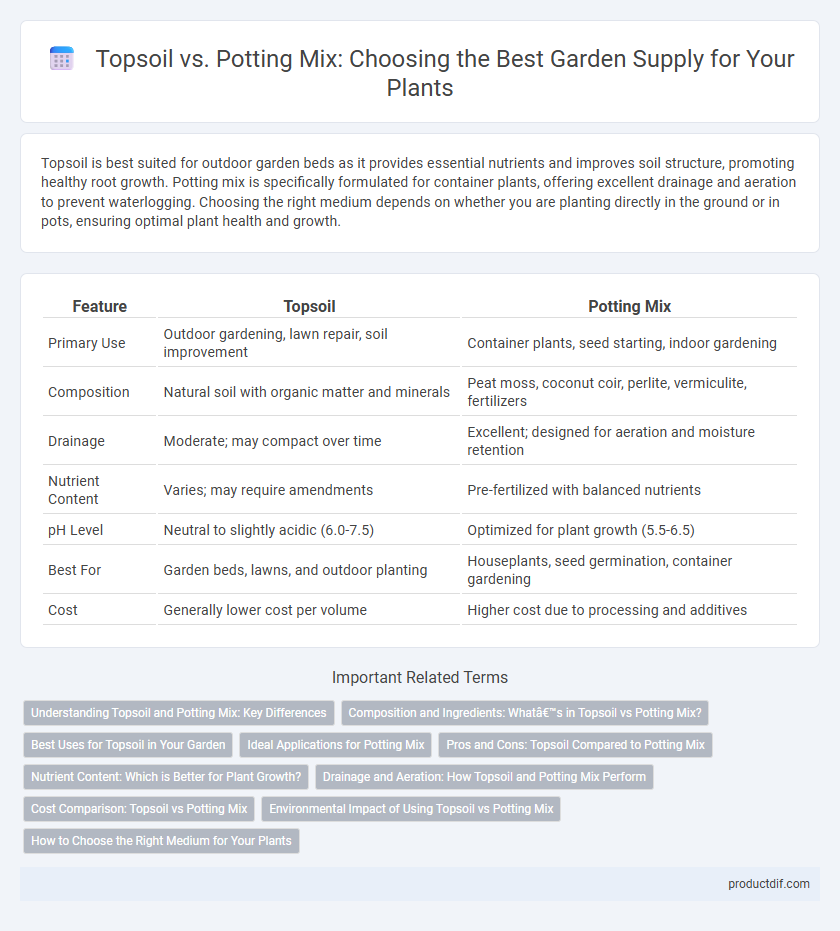Topsoil is best suited for outdoor garden beds as it provides essential nutrients and improves soil structure, promoting healthy root growth. Potting mix is specifically formulated for container plants, offering excellent drainage and aeration to prevent waterlogging. Choosing the right medium depends on whether you are planting directly in the ground or in pots, ensuring optimal plant health and growth.
Table of Comparison
| Feature | Topsoil | Potting Mix |
|---|---|---|
| Primary Use | Outdoor gardening, lawn repair, soil improvement | Container plants, seed starting, indoor gardening |
| Composition | Natural soil with organic matter and minerals | Peat moss, coconut coir, perlite, vermiculite, fertilizers |
| Drainage | Moderate; may compact over time | Excellent; designed for aeration and moisture retention |
| Nutrient Content | Varies; may require amendments | Pre-fertilized with balanced nutrients |
| pH Level | Neutral to slightly acidic (6.0-7.5) | Optimized for plant growth (5.5-6.5) |
| Best For | Garden beds, lawns, and outdoor planting | Houseplants, seed germination, container gardening |
| Cost | Generally lower cost per volume | Higher cost due to processing and additives |
Understanding Topsoil and Potting Mix: Key Differences
Topsoil is primarily composed of natural soil mixed with organic matter, making it suitable for outdoor gardening and landscaping projects due to its nutrient-rich composition and ability to improve soil structure. Potting mix, on the other hand, is a lightweight, sterile blend of peat moss, vermiculite, and perlite designed specifically for container gardening to provide optimal drainage and aeration. Understanding these key differences ensures the right medium is chosen to promote healthy plant growth and prevent issues like root rot or nutrient deficiencies.
Composition and Ingredients: What’s in Topsoil vs Potting Mix?
Topsoil primarily consists of natural soil enriched with organic matter, minerals, and microorganisms, making it suitable for outdoor gardening and lawn preparation. Potting mix includes a blend of peat moss, coconut coir, perlite, vermiculite, and sometimes composted bark to ensure superior aeration, drainage, and moisture retention for container plants. Understanding these ingredient differences is essential for selecting the right medium that supports root development and plant health in various gardening applications.
Best Uses for Topsoil in Your Garden
Topsoil is ideal for improving garden beds, filling low spots, and providing a natural foundation for lawns due to its rich organic matter and mineral content. It enhances soil structure and water retention, promoting healthy root growth for shrubs, trees, and outdoor plants. Unlike potting mix, topsoil is better suited for outdoor gardening projects rather than container planting.
Ideal Applications for Potting Mix
Potting mix is ideal for container gardening and indoor plants due to its lightweight, well-draining composition enriched with organic matter and nutrients essential for root development. Its formulation supports aeration and moisture retention, promoting healthy growth in potted plants, seedlings, and houseplants. Unlike topsoil, potting mix prevents compaction and improves water drainage, making it suitable for plants grown in confined spaces.
Pros and Cons: Topsoil Compared to Potting Mix
Topsoil offers superior nutrient retention and natural microbial activity, making it ideal for outdoor garden beds, but it can be heavy and compact easily, limiting aeration. Potting mix provides excellent drainage and aeration with a lightweight formula, ideal for container plants, though it often requires frequent fertilization due to lower nutrient content. Choosing between topsoil and potting mix depends on specific plant needs and gardening conditions, such as soil structure and moisture retention.
Nutrient Content: Which is Better for Plant Growth?
Topsoil contains natural minerals and organic matter that provide moderate nutrients essential for outdoor planting and landscaping projects. Potting mix is specifically formulated with added peat moss, compost, and fertilizers to supply a balanced nutrient profile ideal for container plants and indoor gardening. For optimal plant growth, potting mix offers superior nutrient content, promoting healthier roots and better moisture retention compared to topsoil.
Drainage and Aeration: How Topsoil and Potting Mix Perform
Topsoil offers moderate drainage and aeration, making it suitable for in-ground gardening where natural soil blends are essential. Potting mix excels with superior drainage and aeration due to its lightweight, porous ingredients like peat moss, perlite, and vermiculite, promoting healthy root development in container plants. Choosing the right medium depends on plant type and container size, with potting mix preferred for potted plants requiring enhanced oxygen flow and moisture retention.
Cost Comparison: Topsoil vs Potting Mix
Topsoil generally costs between $10 and $25 per cubic yard, making it a more affordable option for large landscaping projects. Potting mix prices range from $15 to $50 per cubic foot due to its specialized ingredients like peat moss, vermiculite, and fertilizers essential for container plants. The higher cost of potting mix reflects its enhanced nutrient content and structure, which supports better root growth compared to the bulkier, sandy texture of topsoil.
Environmental Impact of Using Topsoil vs Potting Mix
Topsoil extraction often leads to soil degradation, habitat loss, and increased erosion, which contributes negatively to local ecosystems and biodiversity. Potting mix, typically composed of peat, coir, and other organic materials, can have a significant environmental footprint due to peat harvesting, which releases stored carbon and depletes wetlands. Choosing sustainable alternatives such as compost-enriched potting mix or responsibly sourced topsoil can reduce ecological harm and promote soil health.
How to Choose the Right Medium for Your Plants
Selecting the right growing medium depends on your plant's needs and environment, with topsoil providing natural minerals ideal for outdoor gardens and potting mix offering lightweight, well-draining properties perfect for container plants. Topsoil is rich in organic matter, nutrients, and beneficial microorganisms that support root growth in garden beds, while potting mix typically contains peat moss, perlite, and compost to retain moisture and improve aeration. Understanding these differences ensures optimal root development and healthy plants, whether you're planting in-ground or using pots.
Topsoil vs Potting Mix Infographic

 productdif.com
productdif.com